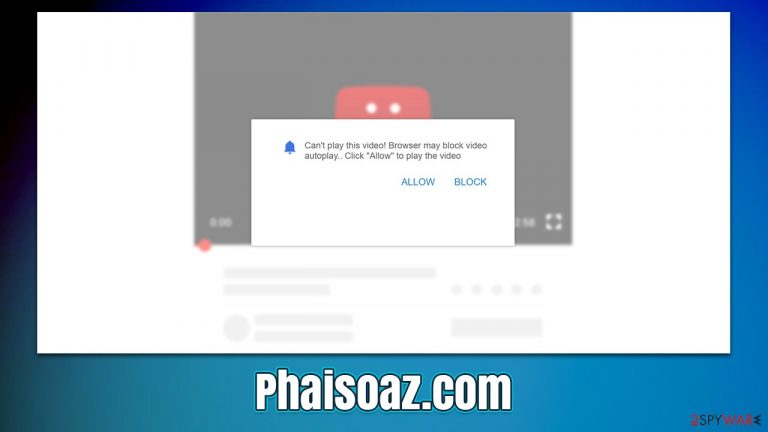Phaisoaz.com ads (Free Guide)
Phaisoaz.com ads Removal Guide
What is Phaisoaz.com ads?
Phaisoaz.com is a fake website that shows misleading messages to make people subscribe to notifications

Phaisoaz.com ads have been showing up on users' desktops recently, and they grew increasingly more concerned over time, as the activity simply doesn't stop. These pop-ups show up at completely random times, regardless of what is being currently done of the system – a video being streamed, favorite websites being visited, or even if the browser is running the background. Likewise, the push notifications would be shown on top of all the other running apps, which makes it particularly intrusive and annoying.
However, the biggest security problem with these Phaisoaz.com pop-ups is their contents. While some of the notifications promoted by the site might not be any different from those you see on various websites, some of them might be particularly damaging. For example, you might be told that you could make a small investment for a huge profit in the future or that that you need to download software to remove malware that was allegedly found on your device.
Without a doubt, these messages should never be trusted and the ads ignored. Otherwise, you might end up installing malicious software on your system, disclosing your personal information, or subscribing to useless services that would charge your credit card every month automatically.
The scam explained
In most cases, users would not navigate through malicious online content intentionally (with a few exceptions), as it would put their computer security at risk. It goes without saying that they mostly end up on the Phaisoaz.com site by accident. As soon as they land on the page, the scam begins to take its shape: there is a background message and a picture that reinforces the idea of the alleged statement. Here are a few examples:
- If you are 18+, tap Allow
- Can't play this video! Browser may block video autoplay… Click “Allow” to play the video
- Click “Allow” to win a prize and get it in our shop!
- Click “Allow” if you are not a robot
- Your file is ready to download. Press Allow to continue
There are plenty of similar websites, such as Webdefencesurvey.com, Bestdailyrewards.com, and Wholenicenews.com, that use the exact same expressions and even pictures to make people click that “Allow” button within the notification prompt. The reason for this is simple: all of these websites have no content and are only made for users to subscribe to notifications as soon as they enter, without thinking much about it.
However, as soon as they oblige, they can quickly notice that there is no other content to explore, and the promised video or a gift is nowhere to be found. Instead, nothing really happens until later, once users start seeing suspicious pop-ups that show up on their desktops.
| Name | Phaisoaz.com |
|---|---|
| Type | Push notifications, ads, pop-ups, scam |
| Appearance | Intrusive pop-ups can start showing up at some point after the “Allow” button is pressed within the notification prompt |
| Symptoms | Pop-up notifications are shown on a desktop at random times |
| Risks | Ads and links to sites displayed by the website might be dangerous: users might suffer from monetary losses, install malware or potentially unwanted programs on their systems, or disclose their sensitive data to cybercriminals |
| Removal | You can disable notifications via browser settings; in case you experience more ads and redirects to suspicious sites, you should check your system with software like SpyHunter 5Combo Cleaner for adware infection |
| Additional steps | You should delete web browser caches and other data from your browsers to protect your privacy and prevent information leaks. You can do that quicker with FortectIntego |
There are almost two billion websites on the internet,[1] so it doesn't take long to make a conclusion that some of them would be dedicated for malicious purposes. While various tech companies and regulatory bodies all work to make the internet a safer place, it is impossible to get rid of everything simply due to the number of websites constantly being created and deleted every single day.
That being said, the internet of today is much safer thanks to security researchers, major tech companies such as Google and Microsoft, as well as law enforcement agencies. There is a lot that can be done from the users' side as well to prevent being a victim of a scam.

How you end up on malicious sites and how to prevent it
As previously mentioned, users end up on malicious websites like Phaisoaz.com thanks to redirects. In most cases, torrents, illegal video streaming, software cracks, and similar content is especially guilty of this. These sites are frequently booby-trapped with various fake “Download” buttons and sometimes might start opening additional tabs automatically thanks to malicious scripts embedded there.[2]
While it is impossible to shield yourself from all malicious content online, the first thing you should do is avoid high-risk websites in the first place. Not only can you end up on push notification scam websites, but you might also get infected with Shgv ransomware or similar dangerous malware. We also recommend employing ad-blocking tools that can be found in the form of simple browser extensions (note: keep in mind that some of these tools might also be untrustworthy, so make sure you download one from legitimate sources only).
There is also a chance that adware or malware is causing unexpected browser redirects. These potentially unwanted applications are solely supported by ads, and, in some cases, those ads can be not of the best quality. The infected users typically see various pop-ups, deals, offers, in-text links, and similar disruptive activity when they browse the web.
The reason why many people are not aware that this software is running in the background is because of adware's distribution methods, which are commonly deceptive. In order to avoid this, make sure you download apps from official sources when possible, and keep in mind that third parties often bundle software,[3] so make sure you watch that installation process carefully and read the instructions properly.
In order to check your device for adware, you should scan your system with SpyHunter 5Combo Cleaner, Malwarebytes, or another reputable security tool. All the programs that initiate random redirects would be included in the antivirus database due to the disruptive behavior. Additionally, it can also check your device for more stealthy infections you might not even know of. If malware or adware is detected and removed, we recommend you also use FortectIntego to clean your browsers and fix virus damage if applicable.
How to remove Phaisoaz.com ads?
Many users mistakenly believe that push notifications are the same as ads they see online. While it is true that both can't appear without the browser being in operation, the latter is only triggered by user actions (after they enter a website that hosts the ad) or by aggressive adware that is installed on the system.
If you have eliminated all the potentially malicious software from your system, the only thing left to do is remove the annoying push notifications by denying Phaisoaz.com to gain access to your desktop via the feature. We explain how to do this in detail below.
Google Chrome (desktop):
- Open Google Chrome browser and go to Menu > Settings.
- Scroll down and click on Advanced.
- Locate the Privacy and security section and pick Site Settings > Notifications.
- Look at the Allow section and look for a suspicious URL.
- Click the three vertical dots next to it and pick Block. This should remove unwanted notifications from Google Chrome.

Google Chrome (Android)
- Open Google Chrome and tap on Settings (three vertical dots).
- Select Notifications.
- Scroll down to the Sites section.
- Locate the unwanted URL and toggle the button to the left (Off setting).

Mozilla Firefox:
- Open Mozilla Firefox and go to Menu > Options.
- Click on Privacy & Security section.
- Under Permissions, you should be able to see Notifications. Click the Settings button next to it.
- In the Settings – Notification Permissions window, click on the drop-down menu by the URL in question.
- Select Block and then click on Save Changes. This should remove unwanted notifications from Mozilla Firefox.

MS Edge (Chromium):
- Open Microsoft Edge, and go to Settings.
- Select Site permissions.
- Go to Notifications on the right.
- Under Allow, you will find the unwanted entry.
- Click on More actions and select Block.

MS Edge (legacy):
- Open Microsoft Edge, and click the Settings and more button (three horizontal dots) at the top-right of the window.
- Select Settings and then go to Advanced.
- Under Website permissions, pick Manage permissions and select the URL in question.
- Toggle the switch to the left to turn notifications off on Microsoft Edge.

Safari:
- Click on Safari > Preferences…
- Go to the Websites tab and, under General, select Notifications.
- Select the web address in question, click the drop-down menu and select Deny.

How to prevent from getting adware
Stream videos without limitations, no matter where you are
There are multiple parties that could find out almost anything about you by checking your online activity. While this is highly unlikely, advertisers and tech companies are constantly tracking you online. The first step to privacy should be a secure browser that focuses on tracker reduction to a minimum.
Even if you employ a secure browser, you will not be able to access websites that are restricted due to local government laws or other reasons. In other words, you may not be able to stream Disney+ or US-based Netflix in some countries. To bypass these restrictions, you can employ a powerful Private Internet Access VPN, which provides dedicated servers for torrenting and streaming, not slowing you down in the process.
Data backups are important – recover your lost files
Ransomware is one of the biggest threats to personal data. Once it is executed on a machine, it launches a sophisticated encryption algorithm that locks all your files, although it does not destroy them. The most common misconception is that anti-malware software can return files to their previous states. This is not true, however, and data remains locked after the malicious payload is deleted.
While regular data backups are the only secure method to recover your files after a ransomware attack, tools such as Data Recovery Pro can also be effective and restore at least some of your lost data.
- ^ How Many Websites Are There?. Websitesetup. Free website setup service.
- ^ What Is BitTorrent and Is It Safe?. Kaspersky. Security blog.
- ^ Bundled software. Computer Hope. Free computer help.
